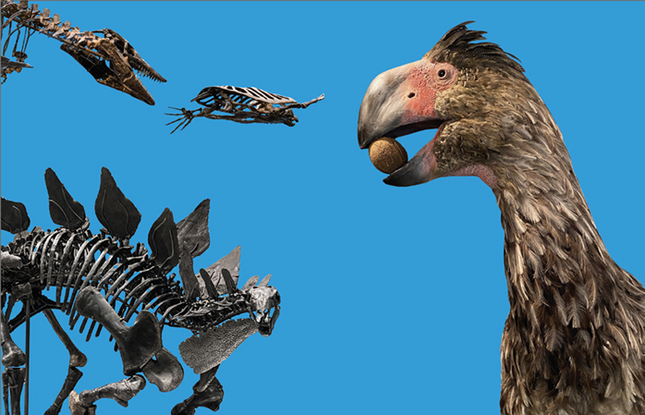
Bob Handelman and Mark Alden Branch '86
Some highlights of the renovated Peabody: a model of a large flightless bird named Gastornis (right), a species that emerged just after the extinction of dinosaurs; a Stegosaurus skeleton (left, bottom) with a new, more active pose; and, hanging in the museum’s central gallery, a scene from the ancient ocean: a Tylosaurus pursues a turtle called an Archelon (left, top). The Archelon fossil was discovered with a missing right rear flipper; the scene suggests what might have happened to it.
View full image

Bob Handelman and Mark Alden Branch '86
Some highlights of the renovated Peabody: a model of a large flightless bird named Gastornis (right), a species that emerged just after the extinction of dinosaurs; a Stegosaurus skeleton (left, bottom) with a new, more active pose; and, hanging in the museum’s central gallery, a scene from the ancient ocean: a Tylosaurus pursues a turtle called an Archelon (left, top). The Archelon fossil was discovered with a missing right rear flipper; the scene suggests what might have happened to it.
View full image
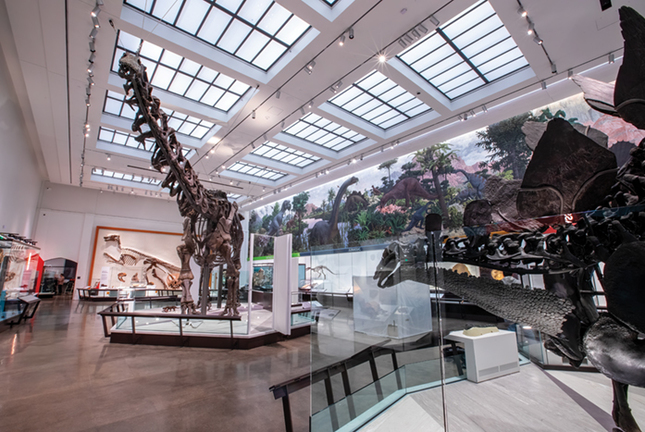
Bob Handelman
The Burke Hall of Dinosaurs features some Peabody favorites—including the giant Brontosaurus—in new poses.
View full image

Bob Handelman
The Burke Hall of Dinosaurs features some Peabody favorites—including the giant Brontosaurus—in new poses.
View full image
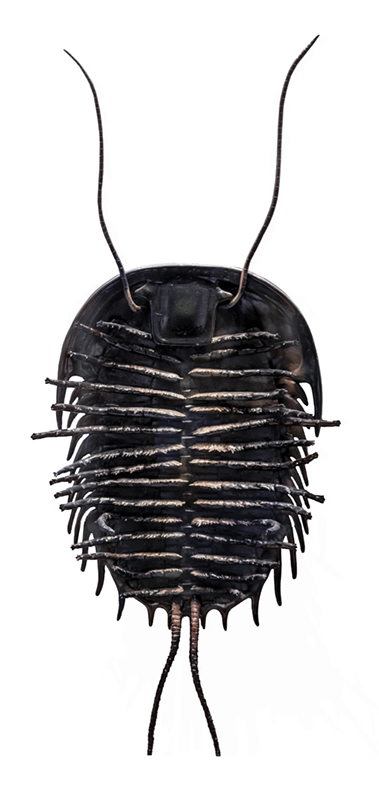
Bob Handelman
The hall also houses an exhibit on ancient oceans that includes both fossils and larger-than-life models of sea creatures, like this model of a trilobite.
View full image

Bob Handelman
The hall also houses an exhibit on ancient oceans that includes both fossils and larger-than-life models of sea creatures, like this model of a trilobite.
View full image
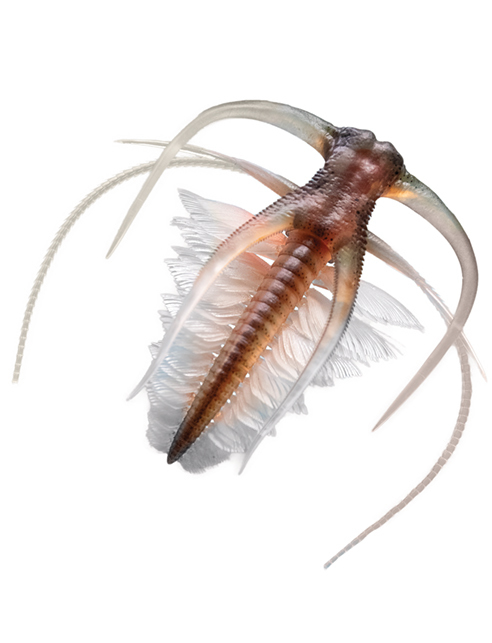
Bob Handelman
Model of an arthropod from the Ancient Oceans exhibit.
View full image

Bob Handelman
Model of an arthropod from the Ancient Oceans exhibit.
View full image
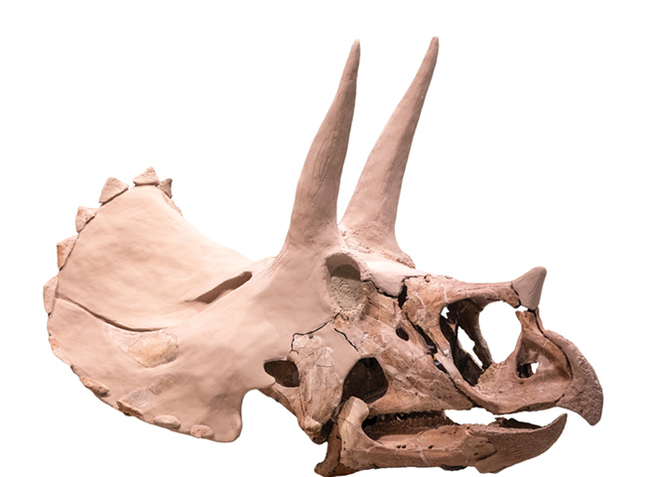
Bob Handelman
A skull on view in the dinosaur hall is thought to have belonged to a juvenile Triceratops.
View full image

Bob Handelman
A skull on view in the dinosaur hall is thought to have belonged to a juvenile Triceratops.
View full image
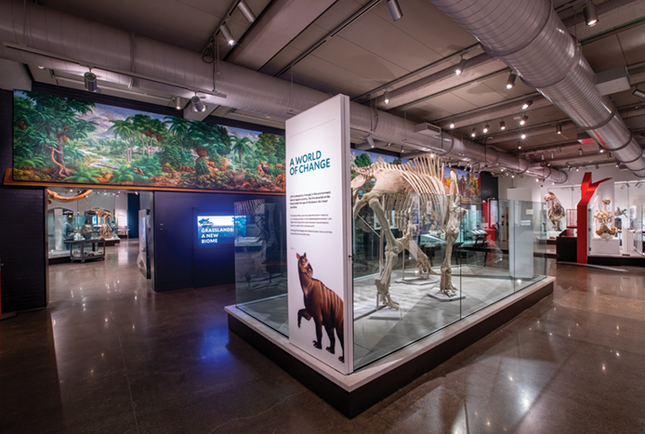
Bob Handelman
A gallery called A World of Change covers the period between the extinction of the dinosaurs and the emergence of humans, a time when the climate became more temperate and large mammals evolved
View full image

Bob Handelman
A gallery called A World of Change covers the period between the extinction of the dinosaurs and the emergence of humans, a time when the climate became more temperate and large mammals evolved
View full image
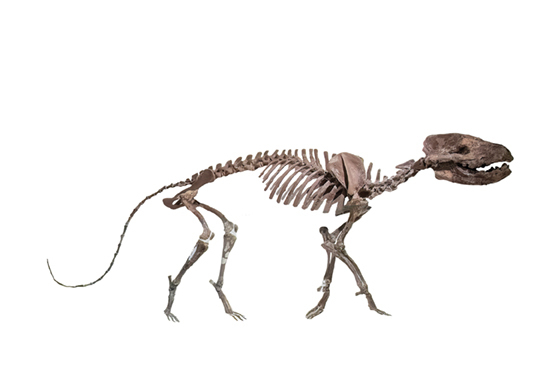
Bob Handelman
Skeleton of an early hoofed predator.
View full image

Bob Handelman
Skeleton of an early hoofed predator.
View full image
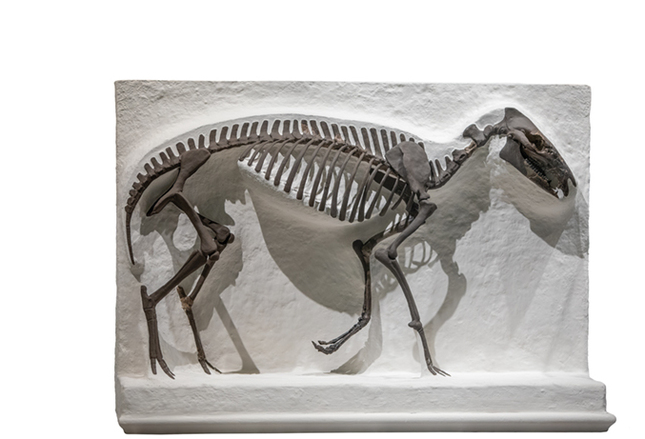
Bob Handelman
A small relative of the modern horse.
View full image

Bob Handelman
A small relative of the modern horse.
View full image
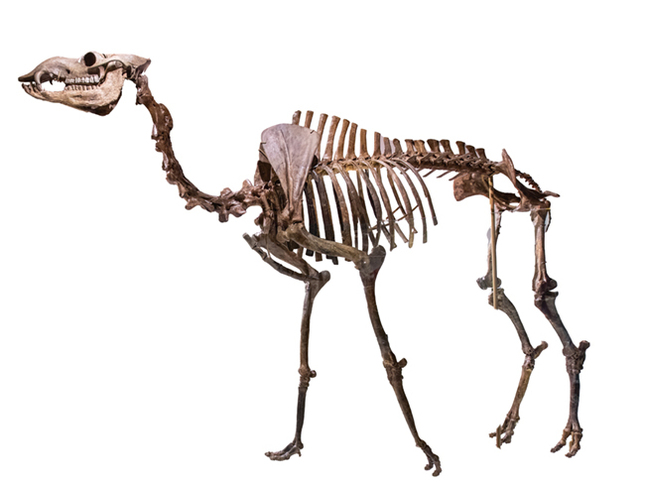
Bob Handelman
A camel unearthed in Nebraska.
View full image

Bob Handelman
A camel unearthed in Nebraska.
View full image
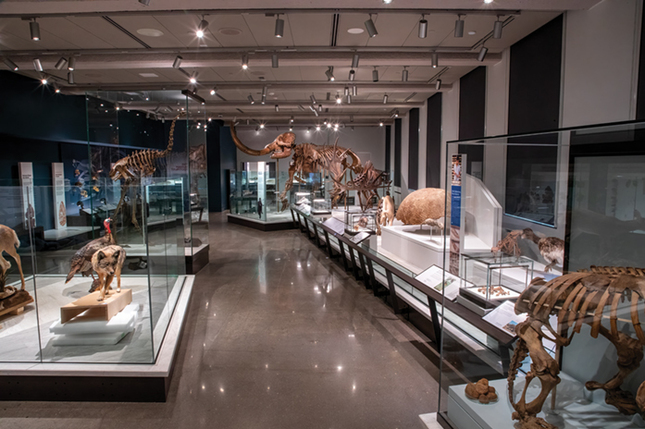
Bob Handelman
The third major gallery on the first floor, The Human Footprint, focuses on the earth since the dawn of humankind.
View full image

Bob Handelman
The third major gallery on the first floor, The Human Footprint, focuses on the earth since the dawn of humankind.
View full image
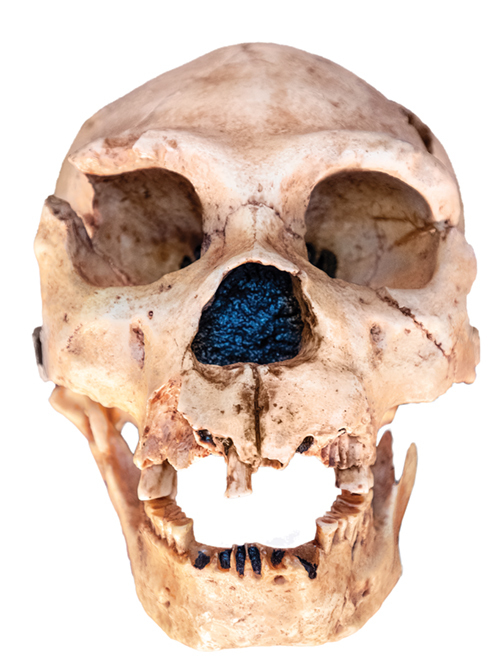
Bob Handelman
The Human Footprint gallery features casts of skulls showing human evolution—like this early Neanderthal man-and animals that coexisted with humans.
View full image

Bob Handelman
The Human Footprint gallery features casts of skulls showing human evolution—like this early Neanderthal man-and animals that coexisted with humans.
View full image
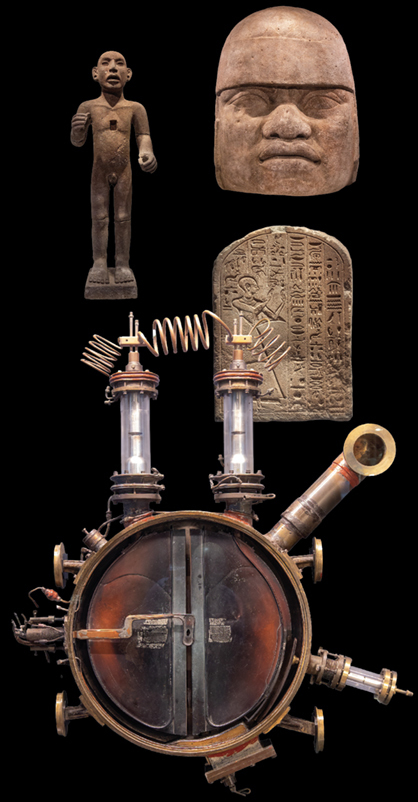
Bob Handelman
Among the objects in the second-floor galleries, clockwise from bottom: a cyclotron vacuum chamber from the History of Science and Technology gallery; an Aztec sculpture of a young man; a cast of an enormous sculpture of an Olmec ruler; and a sandstone monument from ancient Egypt
View full image

Bob Handelman
Among the objects in the second-floor galleries, clockwise from bottom: a cyclotron vacuum chamber from the History of Science and Technology gallery; an Aztec sculpture of a young man; a cast of an enormous sculpture of an Olmec ruler; and a sandstone monument from ancient Egypt
View full image
If you’re a Brontosaurus fan, the first thing you might notice in the newly renovated Peabody Museum of Natural History is that dinosaur’s more energetic appearance: its tail is in the air instead of dragging the ground, and its head is cocked to one side with birdlike alertness.
The change was made for accuracy, says Susan Butts, the Peabody’s director of collections and research. “We know from the fossil record that we see footprints, but we never see a tail mark dragging behind those footprints,” she says. That’s just one of the findings from a generation of research about the prehistoric world that has made its way into the Peabody’s galleries. Thanks in part to a $160 million gift from Edward Bass ’67, the museum has undergone a major renovation and expansion over the last four years. There is now 50 percent more exhibit space and better circulation for visitors and school groups.
“We’ve been able to really totally rethink the exhibition approach,” says Peabody director David Skelly, the Frank R. Oastler Professor of Ecology. “And the net result is, we have more objects that are going to be on display than we ever have before. The galleries are much more opened up, there’s bigger sightlines, you can see more of what’s going on around you. And we’ve given space and air to these incredible objects.”
After four years of waiting—half a lifetime or more for many of the schoolchildren who visit the Peabody as a Connecticut rite of passage—the museum’s reopening on March 26 was something to celebrate. Two busloads of wide-eyed children from New Haven public schools were the first to see the museum on opening day. The Today show aired a five-minute segment with Al Roker checking out the dinosaurs. And the timed, free-admission tickets to the museum—a system established to control crowd size in the opening weeks—sold out through May soon after they became available online.
The excitement was warranted: the renovation by Centerbrook Architects has brought the Peabody into the twenty-first century and made a beloved place better. Windows that were once blacked out now let daylight into some of the exhibit spaces. Administrative offices have been moved to the fourth floor or the basement to make more room for exhibitions. A new skylit central gallery with tables and chairs provides a place to decompress from museum fatigue or just hang out. And on Sachem Street, there is a new entrance for groups of children arriving in buses.
As for the exhibitions—designed by the firm reich&petch in consultation with Peabody’s 22 curators—the three major first-floor galleries have been reconfigured to present a chronological narrative of natural history. As visitors enter the dinosaur hall, they see a display of fossils from the ancient oceans before rounding a corner to behold Brontosaurus, Stegosaurus, and other old Peabody favorites from the age of dinosaurs. The Peabody’s famous Age of Reptiles mural by Rudolph Zallinger ’42BFA, ’71MFA, has been restored; the science behind it is outdated, but it is still an important cultural artifact, reproduced in countless mid-century books and magazines. Skelly says the museum is planning a new artwork of some kind to go on the long wall facing the Zallinger mural.
The next room in the first-floor circuit was once known as the Hall of Mammals, but it is now called A World of Change. Here, the exhibit takes viewers through the millions of years between the asteroid that caused the extinction of dinosaurs 66 million years ago and the dawn of humankind: a period of transition from a hot and humid planet to a temperate one. (In this room, the museum’s second Zallinger mural, The Age of Mammals, shows that progression.) Skeletons of giant mammals, such as the rhinoceros-like Megacerops and an ancient camel dug up in Nebraska, dominate the room.
The third exhibit in the first-floor sequence, called The Human Footprint, explores the evolution of humans and the fate of animals that went extinct due in part to human activity: the mastodon, the sabertooth tiger, the moa, for instance. “What we’re trying to do in this gallery is talk about what has happened as humans have come on the scene without having it be one giant downer,” Skelly says. “We’ve got the development of agriculture and, using corn as an example, domestication of animals, the conservation of natural resources, the way that we interact with the oceans. But we also talk about climate change.”
The Peabody has always had a remarkable collection of historic scientific instruments: microscopes, telescopes, timepieces, and much more. Now, for the first time, there is a permanent exhibition of these pieces in a new second-floor gallery dedicated to the history of science and technology. “We wanted to tell the story of what science is,” says Skelly, “and that begins with people organizing a way of observing the world beyond what they can see with the naked eye.”
The exhibit focuses on science at Yale (beginning with the college's first research telescope from 1813), and not always in a positive light. One case features a device used for intelligence testing and other equipment developed by Robert Yerkes, a Yale psychobiologist who was a proponent of eugenics.
The second floor is also the new home for the museum’s anthropological galleries, which feature artifacts from Egypt, Mesopotamia, Mesoamerica, and the Andes. Some of the greatest treasures are from the Yale Babylonian Collection, which is still mainly housed in Sterling Memorial Library but since 2017 has been affiliated with the Peabody. There’s an early cuneiform version of the epic Gilgamesh; one of the world’s oldest known cookbooks; and a clay cylinder inscribed with an explanation of compounding interest.
The anthropological exhibits also remind visitors that these ancient artifacts are part of a cultural heritage that extends to the present. A new sculpture by Mohamed Hafez, a Syrian-American artist and architect who lives in New Haven, is on display in the Egypt and Mesopotamia gallery. Titled Eternal Cities, it’s a mixed-media representation of a Middle Eastern city, with miniatures of items from the Babylonian Collection sprinkled throughout its chambers.
The galleries on the third floor—the Minerals, Earth, and Space collection, an exhibit called Dynamic Nature, and a series of dioramas depicting North American and Connecticut habitat—were scheduled to open on April 19. Dating back as far as the 1940s, the dioramas are Peabody favorites that have been left unchanged, except for new text panels describing the scenes. There is also a dedicated second-floor space for temporary exhibitions; the inaugural exhibit, scheduled to open in the fall, will be a collaboration with Yale’s Wu Tsai Institute, focusing on perception and cognition.
the renovation will surely enhance the Peabody’s mission to the general public—an important goal for a place that is the only part of Yale many Connecticut residents will ever experience. But Skelly says another important goal is to “double down on Yale’s mission” by supporting teaching and learning within the university. Taking lessons from the Yale University Art Gallery and the Center for British Art, the Peabody has five new classrooms where faculty can schedule classes and bring in objects from the collections for examination. There is also a study gallery where faculty can put objects related to their courses on display, and a gallery set aside for student-curated exhibitions. “We want to diversify the voices who are telling the stories,” says Skelly.
Unlike the university’s art museums, the Peabody used to charge admission. As of its reopening, admission is free to everyone. This policy will surely encourage visitors from the wider community, but Skelly hopes it will also encourage students to make more casual visits—perhaps dropping by between classes on Science Hill and hanging out in the central gallery. Says Skelly: “We want this place to say to anybody who walks in, ‘We’ve been expecting you! Glad you’re here!’’’
 loading
loading